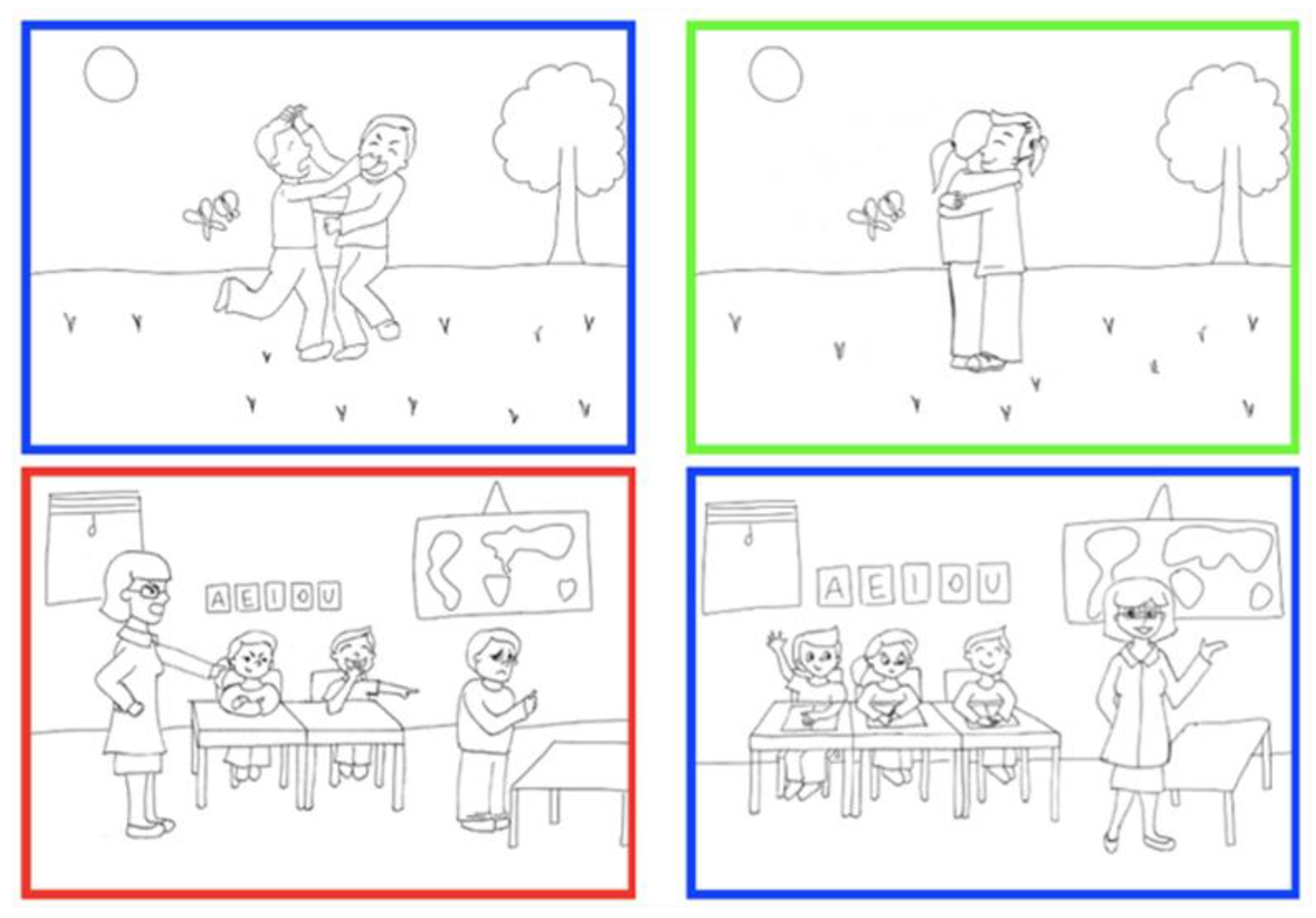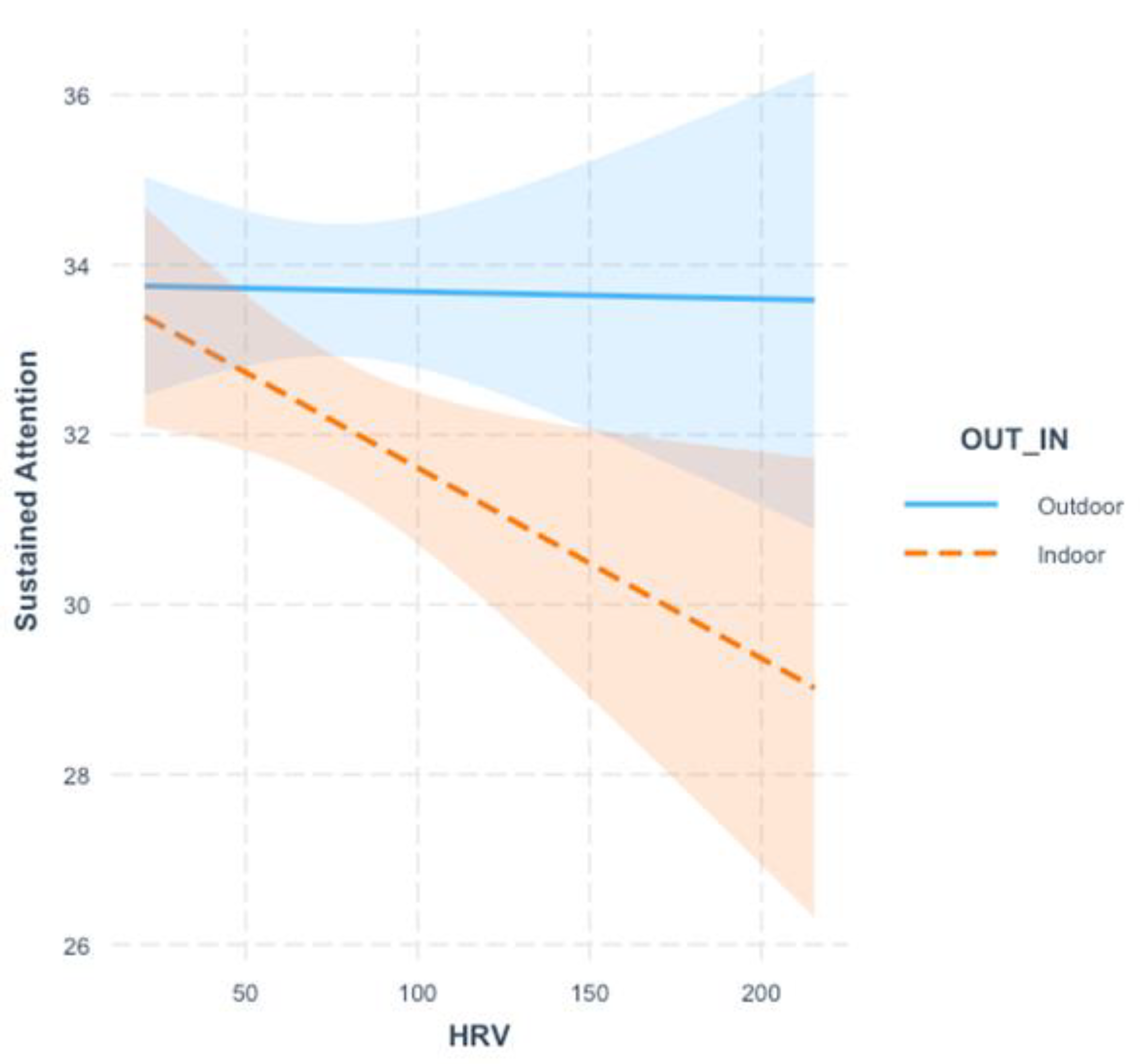Children’s Attentional Processes in Outdoor and Indoor Environments: The Role of Physiological Self-Regulation
Abstract
1. Introduction
1.1. Attention and Exposure to Natural Environments
1.2. Attention and Emotion: The Importance of Physiological Self-Regulation
1.3. Research Questions and Hypotheses
- Step 1: Emotional Stroop Task
- Step 2: Attentional Task
2. Methods
2.1. Study Design
2.2. Participants
2.3. Measures
2.3.1. Emotional Stroop Task
2.3.2. Attentional Task
2.3.3. Physiological Self-Regulation
2.4. Procedure
2.5. Analytical Plan
3. Results
3.1. Step 1: Emotional Stroop Task
3.1.1. Allocation of Attentional Resources and Environmental Background (RQ1)
3.1.2. Emotional Interference, Physiological Self-Regulation, and Environmental Background (RQ2)
3.2. Step 2: Attention in Real Green and Classroom Environments
3.2.1. Selective and Sustained Attention (RQ3)
3.2.2. Attention and Physiological Self-Regulation (RQ4)
4. Discussion
Limitations
5. Conclusions
Supplementary Materials
Author Contributions
Funding
Institutional Review Board Statement
Informed Consent Statement
Data Availability Statement
Conflicts of Interest
References
- Carrus, G.; Pirchio, S.; Passiatore, Y.; Mastandrea, S.; Scopelliti, M.; Bartoli, G. Contact with nature and children’s wellbeing in educational settings. J. Soc. Sci. 2012, 8, 304–309. [Google Scholar] [CrossRef][Green Version]
- Chawla, L. Benefits of nature contact for children. J. Plan. Liter. 2015, 30, 433–452. [Google Scholar] [CrossRef]
- Kuo, M.; Barnes, M.; Jordan, C. Do experiences with nature promote learning? Converging evidence of a cause-and-effect relationship. Front. Psychol. 2019, 10, 305. [Google Scholar] [CrossRef]
- Pirchio, S.; Passiatore, Y.; Panno, A.; Cipparone, M.; Carrus, G. The effects of contact with nature during outdoor environmental education on students’ wellbeing, connectedness to nature, and prosociality. Front. Psychol. 2021, 12, 648458. [Google Scholar] [CrossRef] [PubMed]
- Norwood, M.F.; Lakhania, A.; Fullagarf, S.; Maujeanc, A.; Downese, M.; Byrneg, J.; Stewarth, A.; Barberb, B.; Kendalla, E. A narrative and systematic review of the behavioural, cognitive and emotional effects of passive nature exposure on young people: Evidence for prescribing change. Landsc. Urban. Plan. 2019, 189, 71–79. [Google Scholar] [CrossRef]
- de Keijzer, C.; Gascon, M.; Nieuwenhuijsen, M.J.; Dadvand, P. Long-term green space exposure and cognition across the life course: A systematic review. Curr. Environ. Health Rep. 2016, 3, 468–477. [Google Scholar] [CrossRef]
- Bell, A.C.; Dyment, J.E. Grounds for health: The intersection of green school grounds and health-promoting schools. Environ. Educ. Res. 2008, 14, 77–90. [Google Scholar] [CrossRef]
- Coull, J.T. Neural correlates of attention and arousal: Insights from electrophysiology, functional neuroimaging and psychopharmacology. Prog. Neurobiol. 1988, 55, 343–361. [Google Scholar] [CrossRef]
- Breslau, J.; Miller, E.; Breslau, N.; Bohnert, K.; Lucia, V.; Schweitzer, J. The impact of early behavior disturbances on academic achievement in high school. Pediatrics 2009, 123, 1472–1476. [Google Scholar] [CrossRef]
- Rabiner, D.L.; Godwin, J.; Dodge, K.A. Predicting academic achievement and attainment: The contribution of early academic skills, attention difficulties, and social competence. Sch. Psych. Rev. 2016, 45, 250–267. [Google Scholar] [CrossRef]
- Kaplan, S.; Berman, M.G. Directed attention as a common resource for executive functioning and self-regulation. Perspect. Psychol. Sci. 2010, 5, 43–57. [Google Scholar] [CrossRef] [PubMed]
- Diamond, A. Executive functions. Annu. Rev. Psychol. 2013, 64, 135–168. [Google Scholar] [CrossRef] [PubMed]
- Kaplan, S. The restorative benefits of nature: Toward an integrative framework. J. Environ. Psychol. 1995, 15, 169–182. [Google Scholar] [CrossRef]
- Wallner, P.; Kundi, M.; Arnberger, A.; Eder, R.; Allex, B.; Weitensfelder, L.; Hutter, H.-P. Reloading pupils’ batteries: Impact of green spaces on cognition and well-being. Int. J. Environ. Res. Public Health 2018, 15, 1205. [Google Scholar] [CrossRef] [PubMed]
- Mason, L.; Ronconi, A.; Scrimin, S.; Pazzaglia, F. Short-term exposure to nature and benefits for students’ cognitive performance: A review. Educ. Psychol. Rev. 2022, 34, 609–647. [Google Scholar] [CrossRef]
- Berto, R.; Pasini, M.; Barbiero, G. How does psychological restoration work in children? An exploratory study. J. Child. Adolesc. Behav. 2015, 3, 1–9. [Google Scholar] [CrossRef]
- Mygind, L.; Stevenson, M.P.; Liebst, L.S.; Konvalinka, I.; Bentsen, P. Stress response and cognitive performance modulation in classroom versus natural environments: A quasi-experimental pilot study with children. Int. J. Environ. Res. Public Health 2018, 15, 1–15. [Google Scholar] [CrossRef]
- Taylor, J.G.; Fragopanagos, N.F. The interaction of attention and emotion. Neural Netw. 2005, 18, 353–369. [Google Scholar] [CrossRef]
- Lang, P.J.; Bradley, M.M.; Cuthbert, B.N. Attention and Orienting: Sensory and Motivational Processes. In Motivated Attention: Affect, Activation, and Action; Lang, P.J., Simons, R.F., Balaban, M.T., Eds.; Erlbaum: Hillsdale, NJ, USA, 1997; pp. 97–135. [Google Scholar]
- Ben-Haim, M.S.; Williams, P.; Zachary Howard, Z.; Mama, Y.; Eidels, A.; Algom, D. The emotional Stroop task: Assessing cognitive performance under exposure to emotional content. J. Vis. Exp. 2016, 112, e53720. [Google Scholar] [CrossRef]
- Scrimin, S.; Moscardino, U.; Altoè, G.; Mason, L. Effects of perceived school well-being and negative emotionality on students’ attentional bias for academic stressors. Br. J. Educ. Psychol. 2016, 86, 278–295. [Google Scholar] [CrossRef]
- Berntson, G.G.; Bigger, J.T., Jr.; Eckberg, D.L.; Grossman, P.; Kaufmann, P.G.; Malik, M.; Nagaraja, H.N.; Porges, S.W.; Saul, J.P.; Stone, P.H.; et al. Heart rate variability: Origins, methods, and interpretive caveats. Psychophysiology 1997, 34, 623–648. [Google Scholar] [CrossRef] [PubMed]
- Thayer, J.F.; Hansen, A.L.; Saus-Rose, E.; Johnsen, B.H. Heart rate variability, prefrontal neural function, and cognitive performance: The neurovisceral integration perspective on self-regulation, adaptation, and health. Ann. Behav. Med. 2009, 37, 141–153. [Google Scholar] [CrossRef] [PubMed]
- Siennicka, A.; Quintana, D.S.; Fedurek, P.; Wijata, A.; Paleczny, B.; Ponikowska, B.; Danel, D.P. Resting heart rate variability, attention and attention maintenance in young adults. Int. J. Psychophysiol. 2019, 143, 126–131. [Google Scholar] [CrossRef] [PubMed]
- Porges, S.W.; Doussard-Roosevelt, J.A.; Maiti, A.K. Vagal tone and the physiological regulation of emotion. Monogr. Soc. Res. Child. Dev. 1994, 59, 167–186. [Google Scholar] [CrossRef]
- Thayer, J.F.; Lane, R.D. A model of neurovisceral integration in emotion regulation and dysregulation. J. Affect. Dis. 2000, 61, 201–216. [Google Scholar] [CrossRef]
- Park, G.; Van Bavel, J.J.; Vasey, M.; Thayer, J.F. Cardiac vagal tone predicts attentional engagement to and disengagement from fearful faces. Emotion 2013, 13, 645–656. [Google Scholar] [CrossRef]
- Taylor, C.T.; Cross, K.; Amir, N. Attentional control moderates the relationship between social anxiety symptoms and attentional disengagement from threatening information. J. Behav. Ther. Exp. Psychiatry 2016, 50, 68–76. [Google Scholar] [CrossRef]
- Scrimin, S.; Moscardino, U.; Mason, L. First graders’ allocation of attentional resources in an emotional Stroop task: The role of heart period variability and classroom climate. Br. J. Educ. Psychol. 2019, 89, 146–164. [Google Scholar] [CrossRef]
- Mathôt, S.; Schreij, D.; Theeuwes, J. OpenSesame: An open-source, graphical experiment builder for the social sciences. Behav. Res. Methods 2012, 44, 314–324. [Google Scholar] [CrossRef]
- Biancardi, A.; Stoppa, E. The bells test revised: A proposal for the study of attention in childhood. Psichiatr. Dell’infanzia E Dell’adolescenza 1997, 64, 73–84. (in Italian). [Google Scholar]
- Amicone, G.; Petruccelli, I.; De Dominicis, S.; Gherardini, A.; Costantino, V.; Perucchini, P.; Bonaiuto, M. Green breaks: The restorative effect of the school environment’s green areas on children’s cognitive performance. Front. Psychol. 2018, 9, 1579. [Google Scholar] [CrossRef] [PubMed]
- R Core Team. R: A Language and Environment for Statistical Computing; R Foundation for Statistical Computing: Vienna, Austria, 2021; Available online: https://www.R-project.org/ (accessed on 7 June 2021).
- Perez-Edgar, K.; Fox, N.A. Individual differences in children’s performance during an emotional Stroop task: A behavioral and electrophysiological study. Brain Cogn. 2003, 52, 33–51. [Google Scholar] [CrossRef]
- Kootstra, G.; de Boer, B.; Schomaker, L.R. Predicting eye fixations on complex visual stimuli using local symmetry. Cognit. Comput. 2011, 3, 223–240. [Google Scholar] [CrossRef] [PubMed]
- Li., D.; Sullivan, W.C. Impact of views to school landscapes on recovery from stress and mental fatigue. Landsc. Urban. Plan. 2016, 148, 149–158. [Google Scholar] [CrossRef]
- Schulz, K.P.; Clerkin, S.M.; Halperin, J.M.; Newcorn, J.H.; Tang, C.Y.; Fan, J. Dissociable neural effects of stimulus valence and preceding context during the inhibition of responses to emotional faces. Hum. Brain Mapp. 2009, 30, 2821–2833. [Google Scholar] [CrossRef] [PubMed]
- Stevenson, M.P.; Dewhurst, R.; Schilhab, T.; Bentsen, P. Cognitive restoration in children following exposure to nature: Evidence from the attention network task and mobile eye tracking. Front. Psychol. 2019, 10, 42. [Google Scholar] [CrossRef]
- Tennessen, C.M.; Cimprich, B. Views to nature: Effects on attention. J. Environ. Psychol. 1995, 15, 77–85. [Google Scholar] [CrossRef]
- Luque-Casado, A.; Zabala, M.; Morales, E.; Mateo-March, M.; Sanabria, D. Cognitive performance and heart rate variability: The influence of fitness level. PLoS ONE 2013, 8, 56935. [Google Scholar] [CrossRef]
- Duncan, G.J.; Dowsette, C.J.; Claessens, A.; Magnuson, K.; Huston, A.C.; Klebanov, P.; Pagani, L.S.; Feinstein, L.; Engel, M.; Brooks-Gunn, J.; et al. School readiness and later achievement. Dev. Psychol. 2007, 43, 1428–1446. [Google Scholar] [CrossRef]
- Scrimin, S.; Patron, E.; Florit, E.; Palomba, D.; Mason, L. The role of cardiac vagal tone and inhibitory control in pre-schoolers’ listening comprehension. Dev. Psychobiol. 2017, 59, 970–975. [Google Scholar] [CrossRef]
- Dettweiler, U.; Becker, C.; Auestad, B.H.; Simon, P.; Kirsch, P. Stress in school. Some empirical hints on the circadian cortisol rhythm of children in outdoor and indoor classes. Int. J. Environ. Res. Public Health 2017, 14, 475. [Google Scholar] [CrossRef] [PubMed]
- Barrera-Hernández, L.F.; Sotello-Castillo, M.A.; Echeverría-Castro, S.B.; Tapia-Fonllem, C.O. Connectedness to nature: Its impact on sustainable behaviors and happiness in children. Front. Psychol. 2020, 11, 276. [Google Scholar] [CrossRef] [PubMed]


| B | SE | t | p | |
|---|---|---|---|---|
| Environmental background | 37.59 | 15.03 | 2.46 | 0.02 |
| HRV | −43.12 | 11.20 | −4.82 | 0.01 |
| Age | −31.36 | 15.45 | −2.03 | 0.03 |
| EB × HRV | −23.36 | 10.45 | −1.79 | 0.04 |
| R2 | 0.12 |
| B | SE | t | p | |
|---|---|---|---|---|
| Selective Attention | ||||
| Environment (outdoor vs. indoor) | −5.45 | 2.43 | −2.24 | 0.02 |
| HRV | −0.02 | 0.02 | −1.75 | 0.25 |
| Age | 2.08 | 1.43 | 1.45 | 0.15 |
| Environment × HRV | −0.00 | 0.03 | −0.02 | 0.64 |
| R2 | 0.19 | |||
| Sustained Attention | ||||
| Environment (outdoor vs. indoor) | −4.83 | 1.07 | 1.45 | 0.05 |
| HRV | −1.23 | 8.49 | −0.00 | 0.10 |
| Age | 1.67 | 5.95 | 2.81 | 0.01 |
| Environment × HRV | −2.53 | 1.25 | −2.02 | 0.03 |
| R2 | 0.26 |
Publisher’s Note: MDPI stays neutral with regard to jurisdictional claims in published maps and institutional affiliations. |
© 2022 by the authors. Licensee MDPI, Basel, Switzerland. This article is an open access article distributed under the terms and conditions of the Creative Commons Attribution (CC BY) license (https://creativecommons.org/licenses/by/4.0/).
Share and Cite
Mason, L.; Zagni, B.; Bacchin, F.; Frison, C.; Scrimin, S. Children’s Attentional Processes in Outdoor and Indoor Environments: The Role of Physiological Self-Regulation. Int. J. Environ. Res. Public Health 2022, 19, 13141. https://doi.org/10.3390/ijerph192013141
Mason L, Zagni B, Bacchin F, Frison C, Scrimin S. Children’s Attentional Processes in Outdoor and Indoor Environments: The Role of Physiological Self-Regulation. International Journal of Environmental Research and Public Health. 2022; 19(20):13141. https://doi.org/10.3390/ijerph192013141
Chicago/Turabian StyleMason, Lucia, Benedetta Zagni, Francesca Bacchin, Carlotta Frison, and Sara Scrimin. 2022. "Children’s Attentional Processes in Outdoor and Indoor Environments: The Role of Physiological Self-Regulation" International Journal of Environmental Research and Public Health 19, no. 20: 13141. https://doi.org/10.3390/ijerph192013141
APA StyleMason, L., Zagni, B., Bacchin, F., Frison, C., & Scrimin, S. (2022). Children’s Attentional Processes in Outdoor and Indoor Environments: The Role of Physiological Self-Regulation. International Journal of Environmental Research and Public Health, 19(20), 13141. https://doi.org/10.3390/ijerph192013141






